Hydraulic accumulator: device and principle of operation of a hydraulic tank in a water supply system
To ensure the stable operation of the water supply system, you should find out what a hydraulic accumulator is. This useful device is necessary to automate the operation of an independent plumbing system.
It also allows you to significantly extend the life of the pump and protect equipment from water shocks.
In this material we will talk about the arrangement and principles of operation of hydraulic accumulators, as well as provide recommendations for the installation of equipment.
The content of the article:
Device and principle of operation
The accumulator is distinguished from a conventional drive by a more complex device, which significantly expands its functionality.
It consists of:
- metal case;
- inner membrane;
- nipple;
- branch pipe for water.
The membrane divides the container into two parts, one designed for water, and air or inert gas is pumped into the second. As a result, the fluid inside the device is under a certain pressure. This allows you to adjust the water pressure in the system.
Anyone who has at least once encountered the problem of low pressure in the system can tell about what the accumulator is for. Sometimes a problem is solved with boost pumpbut GA is a more effective option.
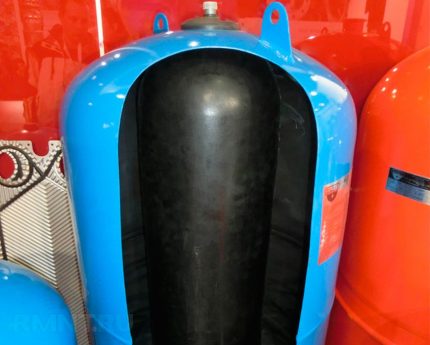
It is installed in the system after the pump on the external or internal water supply, the specific circuit depends on the characteristics of the system. Water enters the tank and accumulates there, while the pressure inside the membrane creates the pressure necessary for the normal operation of an autonomous water supply with trouble-free supply of water to the taps.
Conventional storage does not guarantee suitable pressure characteristics for the water supply, since the pressure is created only due to the difference in the height of the water intake point and the water tank. But with the GA, you do not need to raise the tank to the attic or overpass, since you can pump air to create the desired pressure.
Modern technology, for example, an automatic machine, a hydromassage, a jacuzzi, a dishwasher, can only function when standard pressure in the water supply network. And an ordinary shower is more convenient to take when the stream of water is strong enough, and does not flow in a weak stream.
The hydraulic accumulator must be used in conjunction with a pressure switch that controls the pump that supplies water from the well, well, etc., and a pressure gauge designed to control and monitor the operating parameters of independent water supply.
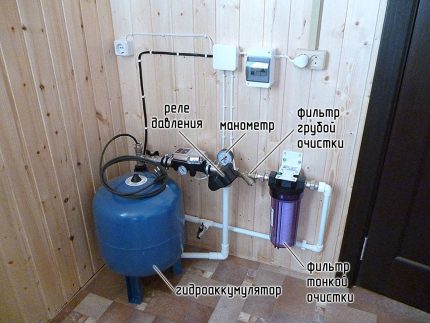
The relays are adjusted so that when the user selects the pressure, the pump switches on and off. When enough water is accumulated in the accumulator and the pressure reaches the maximum set point, the pump will shut off. This indicator, for obvious reasons, is called the shutdown pressure.
During the use of water, the pressure in the tank gradually decreases. When it reaches the minimum set point (this is the so-called turn-on pressure), the pump starts to run. Water enters the tank, the pressure rises, reaches the limit, after which the pump turns off.
Then the water decreases again from the tank, when the owners of the house open the tap, the pressure drops, the relay starts the pump, etc. If HA and relays are excluded from this chain, the pumping equipment will turn on each time the valve is opened. Such use of expensive equipment is irrational, since the resource of its work is limited to a certain number of on-off switches.
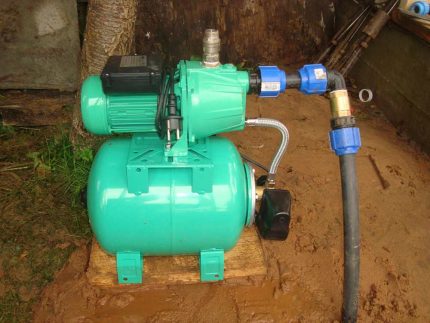
In addition, the pump delivers water rapidly, which may result in a phenomenon such as water hammer. For water, such loads are undesirable, they can damage the pipes. And the accumulator is a durable device that will become a buffer and protect the system from unwanted effects.
Finally, the hydraulic tank allows you to create some stock of water. Even in the absence of electricity, for some time it will be possible to use the water stored in the GA. Of course, this is not such a large supply as in the drive, but it can also be very useful.
What are accumulators?
Distinguish between vertical and horizontal devices, they are installed differently. Typically, tanks with a capacity of up to 50 liters are placed horizontally, and larger volumes - vertically, so as not to take up much space. This does not affect the effectiveness. You can choose a model that will be more convenient to use and suitable for the place where it will be installed.
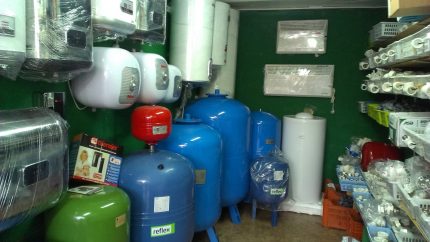
In vertical and horizontal models, a nipple — an air valve — is provided for venting air from the part into which air or gas is pumped. Using it is very simple.
It is located in all types of hydraulic tanks from the side opposite to the installation of the flange, designed to connect the equipment to the water supply.
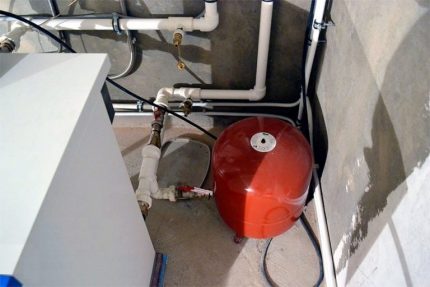
The color of the container is usually blue or blue, in contrast to the red expansion tanks for heating. They are not interchangeable; different materials are used to make the membrane. In "cold" hydraulic tanks use food rubber.
In addition, blue accumulators can carry higher pressures than heating and domestic hot water devices. You can not use such containers for other purposes, they will quickly fail.
In vertically oriented HA, water is supplied from below, and excess air is removed from above, if necessary, by bleeding it through a nipple. In horizontal versions, both the water supply and the air bleed are done from the side.
The threaded connection for connecting to the water supply is always the same size, it is 1 1/2 inches. The thread for connecting the membrane can be internal or external. Their sizes are also unified, the internal thread is standardly 1/2 inch, the external thread is 3/4 inch. This is an important point, since for a reliable connection it is necessary that the dimensions of the pipe and water pipe coincide.
If you plan to organize an independent water supply system, you need to know how a conventional hydraulic accumulator for water is arranged. You should immediately determine the options for connecting to the water supply system and ways to remove air if the pressure exceeds the standard value, as well as with the connection schemes to the system.
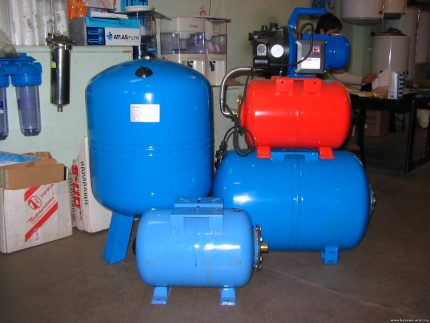
It should be remembered that they were originally designed for the conditions of the country where they were produced, and they do not always coincide with local realities. Operating conditions may be too difficult for Western models, so it makes sense to look for an option from a domestic manufacturer, which may be more attractive at a cost.
Recommendations for installation and operation
Installing a hydraulic tank is not difficult, it is simply connected to the water supply system after the pump. Before entering the device, you need to put a good filter to clean the water from impurities. They can accumulate inside and damage the membrane.
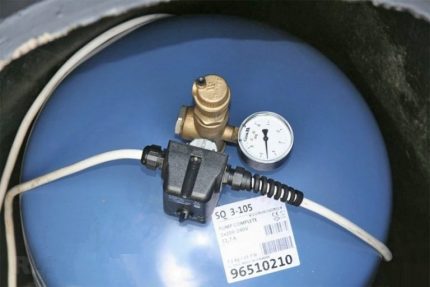
You need to choose the right place for installation. The GA should stand where it is possible to freely approach for inspection of the device and its maintenance. Over time, the device may need to be repaired, so it will not hurt to think through the procedure for its dismantling and the difficulties that may arise at this time.
It is very important that the dimensions of the pipe and the water pipe match. This will avoid hydraulic losses due to the narrowing of the track in some area. The use of adapters is acceptable, but undesirable. The membrane tank may vibrate during the flow in and out of water.
It is recommended to fix it to the base through shock absorbing pads. Connection to the water supply system is carried out by flexible eyeliner. Make sure that the device is correctly aligned horizontally and vertically, skews are unacceptable.
It is necessary to take care in advance of the possibility of disconnecting the hydraulic circuit from the water supply so that it does not have to completely drain the water from the system. This requirement is implemented by installing a conventional shut-off valve. For small containers with a capacity of up to 10 l, in which there is no nipple, a drain valve must also be provided.
Read more about how to connect the accumulator in the water supply system can be found in this stuff.
Maintenance of the hydraulic tank is reduced to a thorough inspection of the housing and pressure control in the air compartment. Sometimes you need to pump air or bleed it to restore the correct performance. Typically, the pressure should be about two atmospheres or slightly less. In addition, air that has accumulated behind the membrane in the compartment where water is stored should be removed.
Sometimes you can even install an automatic air vent here. If there is no hole for this procedure, you must disconnect the hydraulic circuit from the water supply and completely empty it through the drain valve. Air will exit the tank with water. Then it remains just to turn on the pump again so that water starts to flow into the tank again.
Speaking about how the membrane accumulator works, it is worth noting that the most common breakdown in the HA is membrane breakthrough. This elastic element is constantly exposed to tension and compression, and therefore fails over time.
Here are signs that the membrane is broken:
- water comes from the tap with sharp shocks;
- the gauge needle “jumps”;
- after completely bleeding the contents of the “air” compartment, water flows out of the nipple.
The last paragraph allows you to accurately determine whether the problem is really with the membrane. If water does not flow out of the nipple and the water enters the system weakly, most likely the housing is depressurized. It is necessary to carefully examine it, find and repair the cracks.
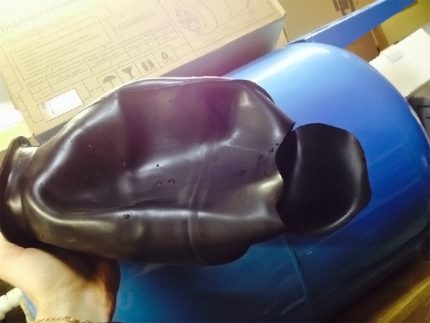
Replacing the membrane is not difficult, but you need to choose exactly the same element as the damaged one, since it is designed specifically for this particular GA.
To carry out repairs, you need:
- Disconnect the device from the plumbing system.
- Drain, bleed air.
- Loosen the fixing screws.
- Remove damaged membrane.
- Install a healthy item.
- Secure it with screws.
- Install the GA in place and connect it to the system.
The most difficult step in this procedure is tightening the screws. It should be uniform, so it is recommended to twist them, making one revolution in turn on each element. This tactic will allow you to properly fix the membrane to the body and prevent its edge from slipping inward.
Some inexperienced craftsmen, in an effort to improve the quality of the joint, apply sealant to the edge of the membrane. This should not be done, since the composition can destroy the rubber and cause the opposite effect.
Conclusions and useful video on the topic
The device and the principle of operation of GA:
For an autonomous water supply system, a hydraulic accumulator is a useful equipment that provides automatic water intake, pump on / off. Such a device will improve the quality of water supply and prevent the breakdown of technical devices.
After studying the material, there were questions? You can ask them in the comments box, and we will try to give them the most understandable answer.

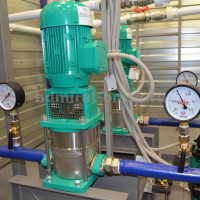 Principle of operation and design of a typical pumping station for water supply
Principle of operation and design of a typical pumping station for water supply  Pumping station without accumulator: operation features and water supply devices without hydraulic tank
Pumping station without accumulator: operation features and water supply devices without hydraulic tank 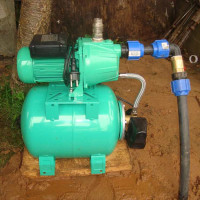 Ejector for a pumping station: operating principle, device, installation rules
Ejector for a pumping station: operating principle, device, installation rules 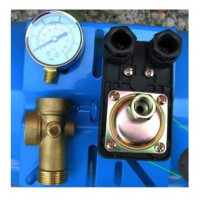 Water pressure sensor in the water supply system: specifics of use and adjustment of the device
Water pressure sensor in the water supply system: specifics of use and adjustment of the device 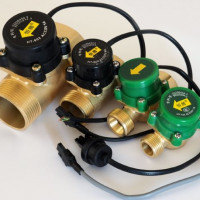 Water flow relay: device, principle of operation + instruction on connection
Water flow relay: device, principle of operation + instruction on connection 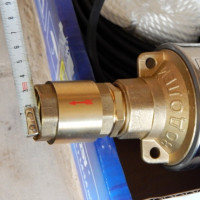 Check valve for the pump: device, types, principle of operation and installation details
Check valve for the pump: device, types, principle of operation and installation details  How much does it cost to connect gas to a private house: the price of organizing gas supply
How much does it cost to connect gas to a private house: the price of organizing gas supply  The best washing machines with dryer: model rating and customer tips
The best washing machines with dryer: model rating and customer tips  What is the color temperature of light and the nuances of choosing the temperature of the lamps to suit your needs
What is the color temperature of light and the nuances of choosing the temperature of the lamps to suit your needs  Replacement of a geyser in an apartment: replacement paperwork + basic norms and requirements
Replacement of a geyser in an apartment: replacement paperwork + basic norms and requirements
My house is connected to the central water supply, but the pressure in it is such that only the first floor is enough. On the second, where we have a shower with hydromassage, the pressure is only 0.5 atmospheres. Therefore, the hydromassage nozzle, which needs at least 1.5 atm, does not work. I had to put a small pump station with a 24-liter hydraulic accumulator.
In addition, I also put a tank for 1 cubic meter of water, from which hydrophore is already taking water and supplying consumers in the house to all points. Now the pressure on the second floor is excellent, about 2 atm. And I also have a supply of water for every fireman.
I am having some problems connecting the accumulator. I have it with two outputs - top and bottom, and on the connection diagram that I found on the Internet, the eyeliner is connected only from below.How to connect it correctly? Or is the top outlet generally for a pressure gauge? A friend says that a safety valve must be installed on top, but he also has no particular experience. I feel tormented with this GA.
The upper outlet on the accumulator is designed for manometers and other things. You can put a five-pass fitting there and wind a manometer, a pressure switch, an automatic air vent, etc. If there is free access, it must be drowned out.